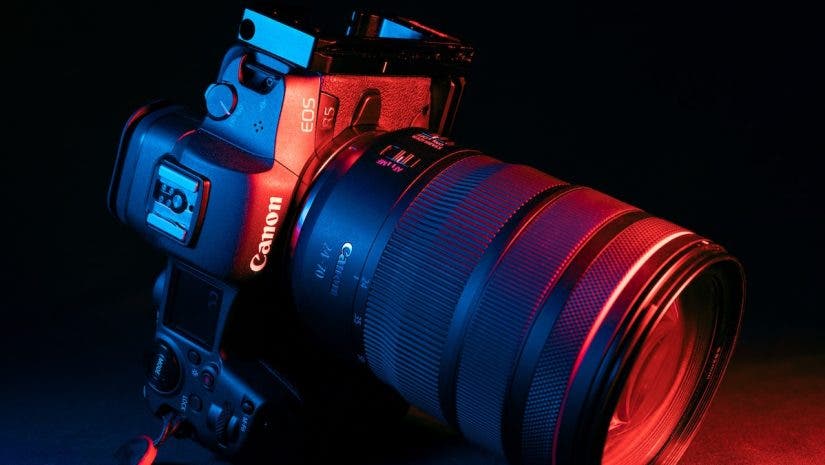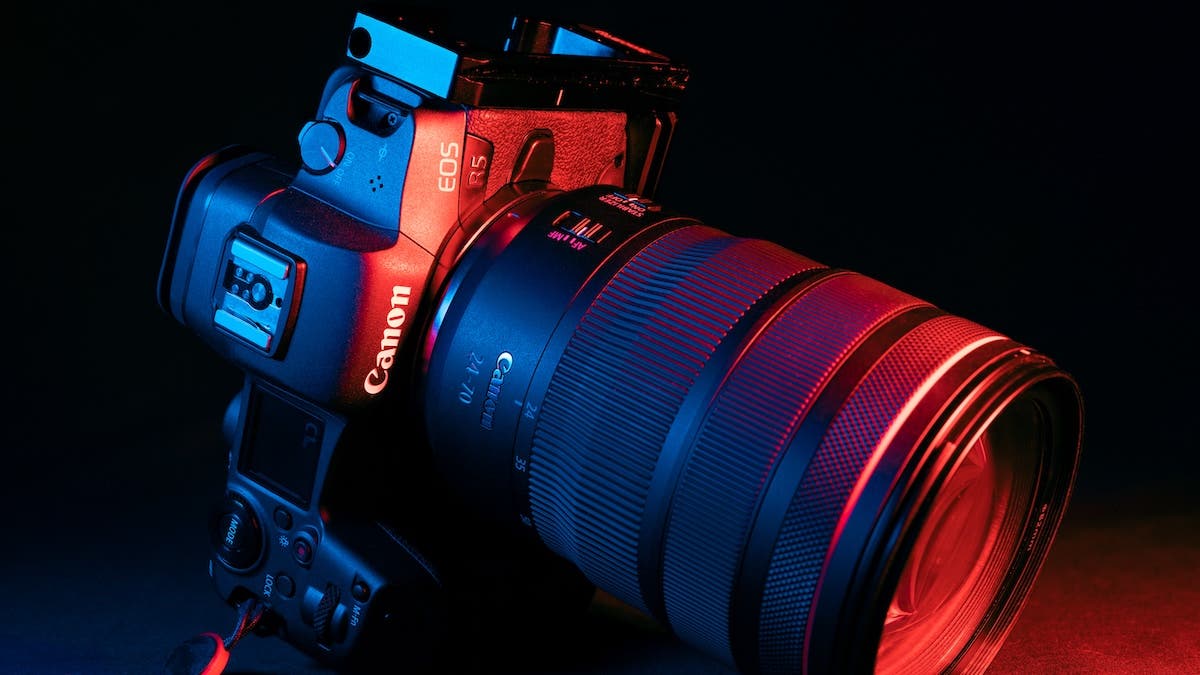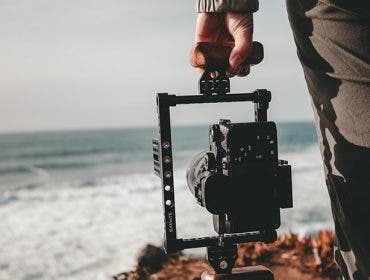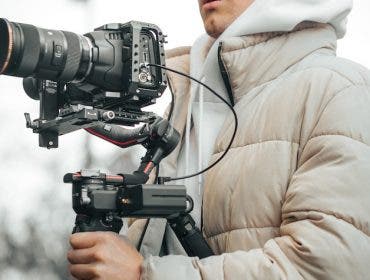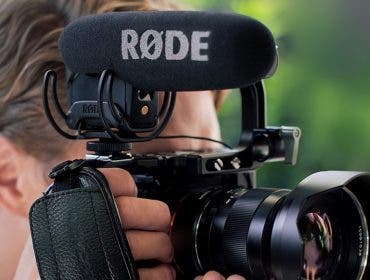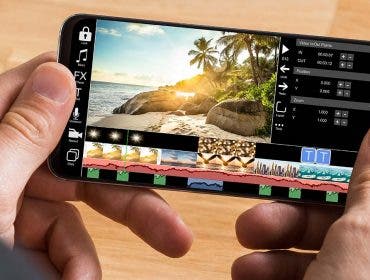While Canon video cameras and camcorders are great for professional and personal video production, not everyone has the budget for pro-level camcorders. Indeed, the easiest, fastest, and cheapest way to produce high-quality videos with Canon gear is to go for their DSLR and mirrorless cameras.
Admittedly, DSLR cameras and mirrorless cameras are not necessarily optimized for videography. Since they are neither video cameras nor camcorders, they only allow up to 30 minutes of recorded footage at a time. Then again, this is no problem if you’re shooting vlogs or short films. That still leaves you with the dilemma of choosing the right Canon video camera for your video recording needs.
To help you find the right Canon model that suits your unique videography needs, check out our short list of the best Canon cameras for video recording.
The Best Canon Camera for Video
Whether you’re looking for a vlogging camera for beginners or you’re a seasoned pro, these Canon video cameras are sure to impress you with their exceptional capabilities for video shooting.
Canon EOS R3 Mirrorless Camera
One of the best Canon cameras for video is the Canon EOS R3 Mirrorless Camera. This powerful camera, part of the brand’s beloved EOS R series, features recording of up to 6K at 60p RAW or 4K at 120 10-bit with Canon Log 3. Plus, the Canon EOS R3 Mirrorless Camera comes with dual-card slots—a must-have safety net for event and wedding filmmakers.
The camera’s ISO range of 100 to 102,400, expandable to 204,800, is a perk for videographers as well. This flexibility lets filmmakers shoot high-quality footage no matter the natural lighting. And, with eye-control autofocus, creators can rest assured their subjects will remain in focus all shoot long.
Check out this hands-on review of the Canon EOS R3 with Ab Sesay to see the camera in action.
Why We Chose This Camera
If you’re interested in a Canon mirrorless camera and your workflow includes a lot of video, you’ll love the R3. The larger physical size compared to other R series cameras will feel familiar if you’re used to a Canon DSLR, and the 6K capability here helps future-proof your investment.
Key Specifications:
- 24 Megapixel Back Illuminated Stacked CMOS Sensor
- DIGIC X Image Processor with an ISO range of 100-102400; Expandable to 204800
- Continuous shooting of 30 fps with electronic (silent) shutter and up to 12fps with Mechanical Shutter
- Improved Dual Pixel CMOS AF with 1,053 AF Points
- First EOS Digital camera to feature Eye Control AF
- 5.76-million-dot & 120fps blackout free EVF with quick response
- New multi-function hot shoe
- Capable of recording 6K 60P RAW or 4K 120p 10-bit (uncropped) with Canon Log 3.
- Dual Card Slots for CFexpress and UHS-II SD Memory Cards
Canon EOS R6 Mirrorless Digital Camera
Another one of the best Canon cameras for video is the Canon EOS R6 Mirrorless Digital Camera. This full-frame mirrorless camera offers 4K cinematic video with a high-performance CMOS sensor and the brand’s DIGIC X image processor.
The Canon EOS R6 Mirrorless Digital Camera comes with an enviable ISO range of 100 to 102,400, expandable to 204,800, which means creators don’t have to worry about low-lit situations—the Canon EOS R6 Mirrorless Digital Camera is ready for the job! Quick autofocusing, an expansive focus area, and head and eye detection work in tandem to ensure subjects stand out in perfect detail.
Check out our hands-on review of the Canon EOS R6 with Vanessa Joy for more information.
Why We Chose This Camera
With 4K capabilities at up to 60fps and a 5-axis in body stabilization system, shooting video clips handheld is a simple proposition with the EOS R6. High-speed focusing combined with full-AF-area coverage helps videographers nail their focus quickly so they can give their undivided attention to their subject and framing.
Key Specifications:
- 20MP full-frame CMOS sensor
- DIGIC X Image Processor and ISO range of 100-102400, expandable to 204800
- Dual Pixel CMOS AF covers roughly 100% area, with 1,053 AF areas
- Subject tracking for people and animals enhanced with Deep Learning Technology
- 4K video recording up to 60 frames per second, 1080p recording up to 120 frames per second
- In-body image stabilizer provides up to eight stops of shake correction
- Dual UHS-II SD memory card slots
- Vari-angle LCD touchscreen
- Built-in Wi-Fi and Bluetooth technology
- Impressive durability, with a dust and water-resistant sealing
Canon EOS 1DX Mark III
The Canon 1DX Mark III is a favorite among professional photographers and videographers. It’s a powerful, premium DSLR camera with top-notch video capabilities, including cinema 4K video capture up to 60 frames per second, and excellent low-light performance.
The autofocus on the 1DX Mark III has been upgraded from its predecessor and features 525 AF areas, improved focus tracking, and an AF sensor with 28 times more resolution.
Simply put, the 1DX Mark III is considered the best DSLR-style Canon video camera, and you’ll be hard pressed to find a better model to suit your professional DSLR filmmaking needs.
Why We Chose This Camera
The EOS 1DX Mark III is packed with valuable features for video, from the manual-focus assistive technology to being able to shoot with CFexpress cards for reliably fast reading and writing speeds. One extra upgrade is that all cord ports are on the same side of the camera, so shooting tethered or while using accessories is much more streamlined.
Key Specifications:
- 20.1MP Full-Frame CMOS Sensor
- DIGIC X Image Processor
- 20MP Photos / DCI 4K Videos at 60fps
- ISO Sensitivity Range of 100 – 102,400 (50 – 819,200)
- Dual Pixel CMOS AF System with 525 AF Areas
- Continuous Shooting Rate of up to 20fps
- 3.2” 2.1m-dot Fixed Touchscreen LCD Monitor
- Weighs 2.75lbs (1,250g)
Canon EOS 5D Mark IV
The Canon EOS 5D Mark IV is another favorite among professionals, but thanks to its more affordable price point, even beginners are able to discover their filmmaking potential with this DSLR powerhouse.
This well-rounded system replaces the 5D Mark III, which was known as the best DSLR for filmmaking for several years. It can also shoot DCI 4K videos at 30 frames per second to internal memory cards and full HD footage to an external HDMI recorder.
With a high-resolution full-frame sensor and advanced image processor, it proves to be very good for shooting videos both indoors and outdoors.
Why We Chose This Camera
The 5D Mark IV is a beloved workhorse camera that’s accumulated a huge fan base. If you’re a photographer who also shoots video, you’ll love how this camera allows you to switch between functions with minimal lag time. Whether you’re recording in 4K or doing a live broadcast, you’ll find that this popular model is more than capable.
Key Specifications:
- 30.4MP Full-Frame CMOS Sensor
- DIGIC 6+ Image Processor
- 30MP Photos / DCI 4K Videos at 30fps
- ISO Sensitivity Range of 100 – 12800 (102400)
- 61-Point Dual Pixel CMOS AF System
- Continuous Shooting Rate of up to 7fps
- 3.19” 1.62m-dot Clear View LCD II Monitor
- Weighs 800g (28.22 oz)
Canon EOS R5
Since Canon first entered the full-frame mirrorless market, the company has released a few iterations with different specifications and features. The Canon EOS R5 is widely regarded as their best full-frame mirrorless camera yet.
With a 45 megapixel sensor capable of recording 8K movies at up to 29.97 frames per second or 4K video at up to 120 frames per second, you can easily start creating professional-quality video footage.
With impressive and helpful features like animal and human subject tracking, in-body image stabilization, and a large collection of compatible lenses, it’s easy to see why so many videographers are excited about the R5. In fact, many devotees swear by the EOS R5 as the best camera for videography from Canon.
Why We Chose This Camera
If you’re looking for a camera that provides equally good video and still-image quality, you should seriously consider the EOS R5. 8K is the future, and this model helps ensure you’re more than ready for it. 5-axis in body image stabilization, expansive AF points, and AI-informed subject tracking are just the icing on the cake.
Key Specifications:
- 45 MP Full frameCMOS Sensor
- DIGIC X Image Processor
- 45MP Photos / 8K Videos at 29.97fps
- ISO Sensitivity Range of 100 – 51,200 (102,400)
- Dual Pixel CMOS with 1,053 AF Areas
- Continuous Shooting Rate of up to 20fps
- 3.2” 2.1m-dot Free-Angle Tilting Touchscreen LCD
- Weighs 1.62lbs (738g)
Canon EOS 6D Mark II
If you’re looking for a full-frame DSLR camera body with an ultra-affordable price tag, the Canon EOS 6D Mark II is a powerful option.
The 26.2 megapixel CMOS sensor can capture beautiful footage in Full HD (1920×1080) at 60fps. So while this photo and video camera may not be the first choice for documentary filmmakers, it’s a solid option for vloggers, influencers, and other content creators.
The 6D Mark II is compatible with a nearly endless collection of Canon and third-party lenses and other accessories, so you can build and grow your video kit over time as budget allows.
Why We Chose This Camera
If you love a robust DSLR for creating video content for the internet and social media, but the 5D Mark IV and 1DX Mark III are beyond your price range, the EOS 6D Mark II is a worthy substitute. The Full HD image from this model is more than sufficient for streaming and vlogging, and you can add an external microphone to achieve perfect sound.
Key Specifications:
- 26.2MP Full Frame CMOS Sensor
- DIGIC 7 Image Processor
- 26.2MP Photos / Full HD Videos at 60fps
- ISO Sensitivity Range of 100 – 40,000
- 45-Point Cross type Dual Pixel CMOS AF System
- 3” 1.04m-dot Vari-angle touchscreen LCD Monitor
- Continuous Shooting Rate of up to 6.5fps
- Weighs 1.51lbs (685g)
Canon EOS R7 Mirrorless Digital Camera Body
With a APS-C sensor, the Canon EOS R7 is the only camera on this list aimed at the prosumer market. Even so, the R7 is worth considering for video applications, thanks to a set of impressive and useful specifications.
Compact and powerful, the R7 has a lightning-fast autofocusing motor, 5-axis in-body image stabilization, subject tracking, and edge-to-edge focusing zones.
Smart Shoe integration supports cable-free audio capture, and you can record for over 30 minutes without worrying about your video cutting off. The R7 offers 4K video resolution up to 60fps, giving you plenty of frame-rate flexibility.
Why We Chose This Camera
Investing in a full-frame mirrorless camera and all the lenses you need can be a considerable undertaking. But when you choose a feature-packed camera like the R7 with a crop sensor, you get greater flexibility in picking lenses designed for crop or full-frame sensors.
Key Specifications:
- 32MP APS-C CMOS sensor
- DIGIC X image processor
- 32MP photos / 4K videos at 60fps
- ISO sensitivity range of 100 – 32,000 (Extended: 100 to 51,200)
- 651 Autofocus zones covering 100% of width and height
- Built-in stereo microphone
- Smart shoe functionality
- Record videos over 30 minutes long
- 3” 1.62m-dot Vari-angle touchscreen LCD Monitor
- OLED 2.36m-dot electronic viewfinder
- Continuous shooting rate of up to 15fps
- Weighs 1.2lbs (530g) body only
Canon EOS C70 Digital Camera Body
Canon’s roster of top cameras for video continues with the Canon EOS C70 Digital Camera. This high-end camera supports Canon Log 2 and Canon Log 3 Gamma, which gives creators full access to the CMOS image sensor capabilities in post-production.
The Canon EOS C70 Digital Camera records video at 4K at 120p, with 2K CROP mode for even more versatility at speeds of up to 180fps. Dual SD card slots give filmmakers peace of mind—particularly on shoot days. And, the Dual Pixel CMOS AF technology incorporates every imaging-sensor pixel to detect focus, ensuring all footage is stunningly sharp and in focus.
Check out our hands-on review of the Canon EOS C70 with Martin Fobes.
Why We Chose This Camera
If cinema cameras overwhelm you in scope, price tag, or both, you’ll likely find that the EOS C70 is a breath of fresh air. Priced like a high-end DSLR or mirrorless camera, the C70 feels like an equally approachable and capable introduction to pro-quality film gear. In particular, the RF lens mount lets you take advantage of an ever-growing collection of high-quality lenses.
Key Specifications:
- Canon Super 35mm Dual Gain Output Sensor
- 16+ stops of total dynamic range
- 4K recording at up to 120fps; 2K recording at 180fps
- Built-in RF mount
- Neutral density filter system built in
- Dual Pixels CMOS AF technology incorporated
- Built-in electronic image stabilization
- First Cinema EOS to feature auto ISO and gain control
- Dual SD card slots for simultaneous recording
- Supports Canon Log 2 and 3, PQ, and HLG recording
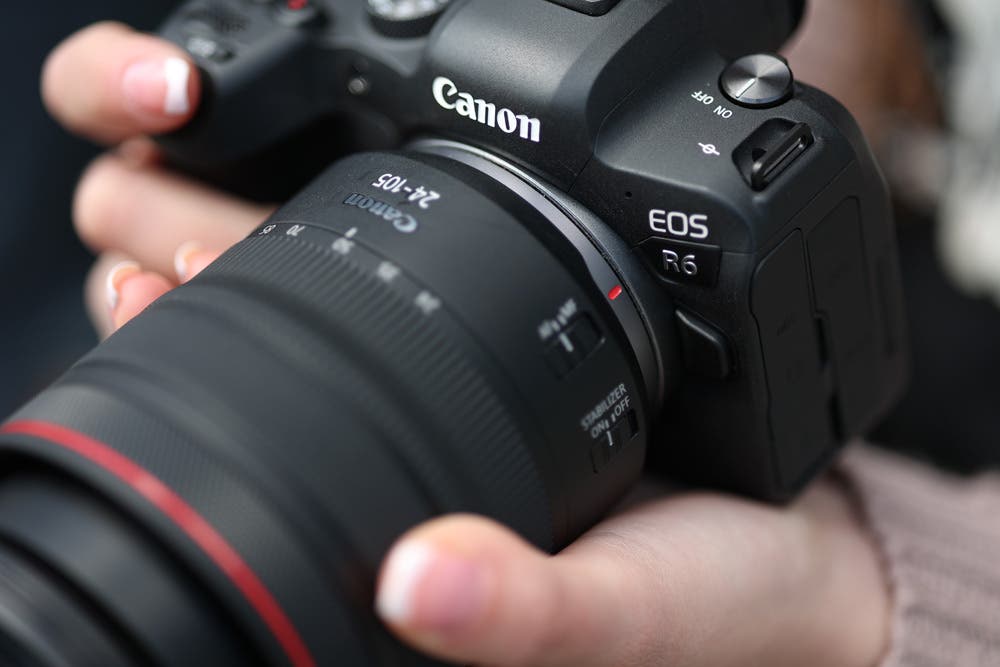
How to Choose the Best Camera for Video?
When it comes to selecting the best Canon video camera for creating beautiful footage, it’s important to balance a few key features. While many new videographers and vloggers place a lot of value on resolution, other features like image stabilization, control functionality, sound inputs, and available lenses are just as important.
Image Stabilization
In photography and videography, you’ll often hear about two main types of image stabilization: in-lens and in-body.
For still photography, in-lens image stabilization is often more than sufficient. Unfortunately, many in-lens stabilization systems are noisy because they rely on a motor.
In videography, any additional source of noise can be problematic, especially when it’s so close to the camera. That’s why videographers prefer in-body image stabilization. It’s silent and quick, and it lets you reduce your shutter speed. With in-body image stabilization you can use any lens in your collection and still enjoy the benefit of shake reduction and improved precision.
If you plan to do most of your video recording on a tripod or using a gimbal, image stabilization is less necessary. But if you like to shoot video content handheld, a body with built-in stabilization is generally the best camera for videography.
Controls – Manual vs Automatic
It’s easy to get started recording video with any lens and camera combination. However, if you want to achieve a professional look for your footage, selecting manual lenses is a good idea.
Many photographers like to achieve great shots quickly by using automatic settings like auto-exposure, camera controlled aperture, and auto focus. When it comes to videography, manual settings are ideal.
Most cine lenses, or lenses designed specifically for video recording, have prominent manual adjustment rings for focusing and changing aperture. Manual focusing unlocks common cinematic effects like smooth focus pulls, while aperture rings ensure you can keep your settings dialed in exactly how you want them.
While it’s possible to record video with automatic settings on lenses and cameras, your artistry and technique will benefit enormously from choosing to work manually.
Sound – External Mic Options
The on-board microphones on most mirrorless or DSLR cameras are often sufficient for casual recordings or for capturing ambient sounds. However, videographers and vloggers who want more control and capability for their video sound will want to invest in a camera with audio inputs.
Whether you want to record with a boom mic, a shotgun mic, or a lavalier mic, choosing a camera with external mic capabilities gives you the flexibility to adjust your sound levels and record improved audio directly into your video file.
Sure, you could always sync audio that you’ve recorded with a microphone and your cell phone (or another audio device) later on in post production. However, that process involves careful timestamp matching, which will definitely add time to your workflow.
By selecting from video cameras with external mic options, you avoid sound-recording headaches later. You also ensure that you get exactly what you want.
Sensor Size
It’s perfectly possible to shoot video with a crop-sensor camera. Most introductory DSLRs feature a crop sensor, and they’re still capable of filming passable video. But if you’re serious about videography, you need a full-frame sensor.
For starters, a full-frame sensor generally offers higher resolution than a crop sensor. If you’re hoping to record in 4K or even 8K, a full-frame camera is your best bet. Beyond resolution, a full-frame sensor also offers a few other benefits.
Full-frame sensors give your footage a wider range of physical real estate. Your lenses can achieve their true focal length, so an ultra-wide-angle lens captures more of a small room. Larger sensors also provide a shallower depth of field compared to crop sensors, delivering a look that many videographers intentionally use in their filming.
Lens – Does it Suit Your Needs?
Selecting the right lenses for use with video cameras comes with a few key considerations: focal length, focusing and aperture rings, maximum aperture, and the general look and feel of the resulting footage.
While you can film video with lower-quality glass and add interesting film effects or filters in post production, there’s an inherent benefit in using high-quality lenses with multi-layer coatings. If your goal is a clean look with tack-sharp focus, limited aberration, and minimal flare, you need to select quality glass.
If you plan to work both in still and moving images, then regular photographic lenses can often work well. However, if you intend to focus primarily on videography, investing in manual lenses is the ideal path to gaining more control over focus, aperture, and the look of your finished product.
Feature photo by Ravi Palwe on Unsplash
